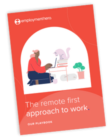A Comprehensive Remote Working Guide
Remote working – whether via a hybrid or fully-remote approach – is now a front-of-mind consideration for many business owners and employees across the UK. Let’s look at how to do it right.

While remote work for most began as an involuntary and short-term solution to a changing world, it is now a front-of-mind consideration for many business owners and employees across the UK and globally.
For some, this work style has had a positive impact, opening doors to a range of opportunities that before were beyond reach. For others, having a distributed team of remote workers has led to challenges that feel unsolvable with even a week’s worth of video calls, remote check-ins and virtual team meetings on the calendar.
According to Employment Hero’s recent survey into the state of wellbeing at work, 57% of fully remote workers in the UK rate their work/life balance as ‘above average’ compared to only 38% of in-office workers and 44% of hybrid workers.
Wherever your business is positioned on your approach to working from home, it is clear that it’s an important matter to navigate from an employee’s point of view.
With prospective staff increasingly focusing on their work/life balance and with many workers having had a taste of the freedom working from home can bring, the option to work remotely has become an employee expectation, whether full-time or as part of a hybrid offering.
As an employer, it’s important to take note of this and allow for remote jobs, or you could see top talent walk out the door to a more flexible organisation.
Key points:
- Remote work, initially a short-term solution, has become a major consideration worldwide due to its potential benefits.
- Remote work allows employees to work outside the traditional office setup and regular hours, promoting flexibility and reducing commuting stress.
Remote work offers benefits such as improved work/life balance and increased talent pool but also requires thoughtful implementation to maintain team culture and productivity. - Employers must develop a remote working policy to meet legal and care obligations to their remote teams.
- Trust between team members is foundational for effective remote teams, with employees and employers needing to work harder to build it.
- When managing remote teams, employers should focus on the output delivered by remote workers rather than hours spent working.
- Implementing OKRs can help align and track remote team goals across the company.
- Essential remote working tools like Asana, Employment Hero, Zoom and Slack can greatly improve remote productivity.
What is the meaning of remote work?
Remote work enables employees to work outside of a traditional office environment and the conventional 9-5 hours.
Whether that environment is a home office, a co-working space or a local coffee shop, it’s about empowering your employees to choose where and when they work best.
A remote work approach is driven by the belief that work can be completed successfully without workers being bound to a physical location.
For an employee, to work remotely means no commute to the office, no designated desk and more flexibility in completing projects and achieving goals in a location of their choice.
For an employer, this can result in increased staff retention, reduced overheads and a happier, more productive team – but more on the benefits of a remote work approach later.
When it comes to remote working, there isn’t a one size fits all solution. It’s important to remember that remote work will mean different things to different remote companies.
As an employer, it’s up to you to develop your own definition of remote work that meets your organisation’s unique structure, goals and objectives.
Read more: How to outsource hiring international employees
Developing your own remote work definition
It’s no secret that working remotely in the UK (or from home) has become a popular workplace trend. What this trend has revealed is the immense potential of businesses and their remote employees in the digital age. With the right attitudes, tools and technology in place, we are seeing firsthand the lasting benefits that remote work can provide.
This realisation has compelled many business owners to use learnings from their quick-fix solutions to develop long-term remote work plans that fit their organisation.
Designing your own definition of remote work means thinking from two different perspectives; your own and your employees.
- What does a mutually beneficial solution look like in your organisation?
- How does remote work impact team culture?
Once you’ve identified your needs, it’s time to choose a remote working option for your organisation:
Remote-first approach
A remote-first approach, for example, could provide your employees with the flexibility they need to work when and where is best for them, depending on their current situation.
With this model, deep work is completed at home or in a remote location, and physical workplaces are for socialising, coworker interaction, and collaboration.
The best part about a remote-first approach is that you can still support and guide those who are unable to work from home effectively, as they have the option to work in the office should they choose to.
Hybrid working
A hybrid work-from-home model is a happy medium that allows employees to enjoy the benefits of both a traditional and virtual workspace. A hybrid model with long-term remote work options allows employees to benefit from face time with their colleagues as well as greater flexibility and family time.
Fully-remote working
In a fully remote company there is no office setting and your employees or freelancers never attend a physical workspace.
Having a fully remote team is an increasingly popular option for many businesses who want to access a much wider candidate pool to fill their positions and enjoy the many other advantages of a remote-friendly structure.
While there is additional bureaucracy and checks required to hire international staff in the UK, even remotely, the savings made on physical office spaces and lower staff entertainment costs may make this a healthy balance, particularly if your business could benefit from employees with experiences or language skills that are harder to find in the UK market.
Understanding the trends of remote working
Our notion of ‘work’ is on the verge of transforming completely, becoming a thing we do as opposed to a location we go to. Work hours will become fluid as we focus more on output instead of input.
To support this, emerging technologies will expand the possibilities of remote work and leaders will be required to play a more active role in supporting mental health and connection in their teams.
So, if this is the case, will we have offices at all in the future? Our research found that the thing workers miss the most about the workplace is the social aspect.
They miss easily bouncing ideas off coworkers (63%), the camaraderie and friendship of colleagues (50%), ease of communication with a team leader or manager (36%) and the general energy of the workplace (34%).

Clearly, face-to-face interaction with co-workers is one of the things that we value the most about our work experience, and we predict that future offices and workplaces will become dynamic environments to cater for this.
However, even without a physical workplace, there are always ways to improve face-to-face communication and collaboration virtually to ensure fully-remote staff aren’t missing out.
Read more: Top Work From Home Trends
What are the benefits of a remote team?
It’s taken a global pandemic to teach us that we can perform our role away from our traditional workspaces.
Before the crisis, the vast majority of us would manage the pressure of our daily routines without realising just how exhausted we were, partly because it’s all we’d ever known.
Lengthy commutes were the norm, but now, thanks to remote work, we’re using that time to be with our families.
1. Help your team facilitate a better work/life balance
We know that working remotely instantly grants your team greater work/life balance and without this, the daily grind can cause workers to burn out.
Based on our recent wellbeing at work survey, we found that 29% of UK workers cite financial pressures and the cost of living crisis as being their main source of stress currently.
Not only does working remotely give your team time back, but it also gives them more money in their pocket, without having to factor in commuting fees like petrol costs, parking fees, train or bus fare, or eating out more frequently for lunch. On top of this, remote working can be hugely beneficial to working parents, those with caring responsibilities, or disabilities, for whom flexibility and a home environment allow them to manage their responsibilities and needs more effectively.
And more generally, everyone can benefit from a little more time spent with friends, family, loved-ones, or simply enjoying your passions and hobbies outside of work.
It’s things like this that can make all the difference to your remote team. It’s up to them to manage their new remote work environment and it’s up to you to guide and above all, trust your team. A happy and fulfilled workforce is one that has a work/life balance.
Read more: Tips for employees working from home
2. Open up your talent pool domestically and internationally
Gone are the days of attracting top talent within a 50 mile radius of your office. A remote approach means no boundaries when it comes to location. This means that your talent pool instantly increases and your new employees could work in the U.S, Australia, Canada or anywhere!
The career opportunities that you provide are no longer bound by location but instead are open to different counties and even countries. This means you’ll have more choice when it comes to hiring top talent. Better yet, this can lead to a decrease in time to fill roles, which can save you money in the long run.
Read more: How can an employer of record help hire internationally?
3. Reduce your overheads
This one is a no-brainer. No office space at all means no overheads for that cost centre, just like a smaller space means reduced overheads, and offices used less frequently or by fewer people will result in lower bills than when operating at full capacity. With the cost of living affecting not just employees, but business owners as well, with higher energy prices, soaring rents, and expensive city-centre prime office locations, perhaps downsizing could be a good move for staff and businesses alike?
4. Create an inclusive working environment
When introducing remote work to the mix, you create the opportunity to improve inclusiveness and diversity within your business.
Essentially, you are broadening your candidate pool to include people with different backgrounds or beliefs. This approach can help reduce inequality by creating more equitable employment opportunities for those who may not have them otherwise.
People such as parents, carers, people with disabilities and those unable to commute to the office due to their geographical location have often been excluded from the full range of career options, and this is your opportunity to change that.
5. Contribute to increased employee happiness and productivity
This one is a biggie. Our recent research into wellbeing at work shows that 65% of workers have felt burnt out due to work in the past year, and 34% have taken leave due to stress of professional burnout.
Of course many factors can contribute to workplace stress, and not all of these will be fixed by implementing a flexible or remote working policy. A holistic approach should be adopted to ensure that as an employer, you are taking the appropriate measures to guide your team on finding the right work/life balance.
However, our survey also showed that fully-remote workers had the best work/life balance, with hybrid workers coming in 2nd place, and full-time in-office workers a clear last place. By introducing flexible work policies, businesses stand to improve their desirability, increase retention rates and create a healthier (and thus more productive) work culture.
Looking for transition into a flexible workplace? Download our flexible work policy template here.
What does remote working in the UK look like?
From a geographic perspective, the UK is a perfect candidate for remote, or hybrid working. With one common timezone, one common language, and a great network of technology and transport links between all towns, cities, and villages, there aren’t many huge barriers (in theory!) to implementing remote working.
However, while most workers prefer flexibility and at least some level of remote working in the UK today, there are some important factors to consider when planning remote working policies in a UK-based company.
Are all employees able to work from home?
A recent survey of working adults in Great Britain by the Office for National Statistics (ONS), showed that 65% of employed 16-24 year olds are not able to work from home. While this is a barrier most of all for young people who are more likely to live with parents, or living in shared spaces or smaller homes with no office space, this remains a barrier to between 38%-53% of people in all other age groups as well.
Is your company able to offer remote or hybrid working?
It’s a fact that some jobs just are not suited to remote working. In-person jobs like those in healthcare, the service industry, or manufacturing are by their very nature always going to be office-first workplaces. That said, just because traditionally there has been less room for experimentation in hybrid approaches in these fields, doesn’t mean it’s not worth trialing.
Is there any regular administrative work that could be done reasonably from home for example? Giving staff the option to work remotely can be a great gesture, even if it’s only ever going to be possible for a small percentage of tasks, and gives you a way to stand out from more traditional competitors.
If you aren’t able to offer any flexibility in remote working, another option to stand out against competitors could be to provide better benefits to staff through reduced/free parking when visiting the office, or travel cards to help with the rising costs of commuting.
Developing your remote working policy

As an employer, you want to ensure that your organisation is covered legally and that your duty of care obligations to your remote teams are met.
Developing a policy for your business may feel like a daunting task, but our Remote and Flexible Working Policy and Remote Working Employee Agreement template can help.
Whatever the work situation, as an employer you have a duty of care to ensure the health and safety of your remote workers. It is your responsibility to guide your team and provide advice on best practices on how to safely work from home.
Additionally, you should ensure your workforce understands how to work from home and complete their jobs efficiently.
Having certain work processes and procedures in place can assist in supporting your “work from anywhere” policy.These include:
- Providing equipment and training to facilitate offsite productivity
- Encouraging transparent communication with clients, suppliers and teammates regarding a remote coworker’s arrangements
- Ensuring employees who work remotely are offered opportunities that are aligned with their office-bound team members
And don’t forget the little things! Put remote employee anniversaries and birthdays in the calendar and make sure you celebrate them. Together, these processes can go a long way in supporting your remote work model.
How to develop trust with remote employees
Establish Objectives and Key Results (OKRs)
OKRs are an effective way to manage your team’s goals. They provide transparency across the entire business and allow your team to know how they’re contributing to the broader business goals.
Having goals in place provides structure and alignment to help your employees stay focused. Be aware that successfully establishing OKRs remotely will involve a different approach compared to sitting around a table in the office.
Create measurable goals
This is an important factor when it comes to goal setting with OKRs. When managing remote workers, you may find yourself falling into the trap of setting goals and OKRs that are tasks on ‘to-do’ lists, rather than actions to support goals more specifically.Goals for remote teams should be numerical and ambitious. They should also be SMART:
- Specific
- Measurable
- Achievable
- Relevant
- Time-bound
Making sure your team’s OKRs are solid from the offset and easily measurable without having to physically oversee your team’s work or performance which may happen more naturally in an office environment, will be crucial for helping remote team members reach their goals.
Provide regular updates and opportunities for feedback
When working in remote environments, it can be easy to lose the accountability that is more routine when teams are working in an office.
In your weekly 1:1s, dedicate 5 minutes to going over your OKRs and create an action plan for that week.
By breaking down the task, it will seem more manageable and allow your remote employees to stay on track. It also means that you won’t have your team members stressing out when it’s the final week of the quarter.
In your weekly meeting, some questions you could ask are:
- Are we on track with our quarterly goals?
- What are you committing to next week to progress your OKRs?
- What have you learned?
Ensure all teams are regularly updating & reflecting on their OKRs
If you have regular company-wide meetings online, ensure your leadership team is providing updates on your OKRs. This might include a broad breakdown of the percentage of people who are and aren’t updating their OKRs, or highlighting particular teams whose employees are flying and who are managing the process well.
This isn’t to single people out but to act as a reminder that everyone should be aligned to company-wide OKRs and continually be working towards their personal and business-specific goals.
How to develop trust with remote employees
The questions we are hearing frequently from leaders are – how can I trust my employees to be productive? And, how can my employees prove that they are getting the work done?
The simple answer to these questions is that it’s a two-way street and both parties need to work that little bit harder to foster trust when working remotely.
If we go back to basics, trust is foundational for creating an effective team. Employees need to trust that they are safe, respected and will get paid correctly by the company that they work for, and companies need to trust that their teams are positively engaged and will deliver what the business needs of them.
As an employer, it’s important that you are equipped with the solutions and practical strategies needed to develop a high trust culture within a remote workplace.Here are a few that keep our remote teams assured and accountable.
Communicate often
When operating from a remote environment, communication and trust has never been more important. It goes further than just spoken words but includes tone and body language. This is why it’s so important to encourage everyone in your team to have their cameras on during meetings.
Set clear expectations
Setting clear goals and expectations is critical for building trusting relationships. Be sure to clearly articulate what it is you want each team member to achieve throughout the course of the day. If an activity needs to be finished before a deadline, set reminders for those responsible to prevent anyone steering off track.
Focus on output over hours
One of the biggest concerns that managers face when their employees are remote is that they’re unable to track how long each person remains in their seat or at their laptop as they would with 9-5 hours in the office.
Monitoring teams who work remotely means trusting them to accomplish exactly what was agreed to. The last thing any employee wants is to feel as though they’re continually being watched. In truth, your employees may well be making a snack in the kitchen, spending longer preparing lunch than usual or even watching cute dog videos on youtube.
Remote work requires accountability, and if a worker fails to deliver, they must communicate why.
Check-in regularly with 1:1s
A one-on-one is a scheduled meeting in your calendar and your mental map for an open-ended and anticipated conversation between a manager and an employee.
These meetings are intended for coaching, mentorship, context or even venting, however, the value of one-on-ones is for leaders, teammates, and peers to connect and communicate. As a manager, effective one-on-ones should leave employees feeling heard, safe, and empowered.
Get regular employee feedback
Feedback is so important to success because without it, you don’t know where to improve. When it comes to engagement, employees who receive feedback – good or bad – are twice as likely to be highly engaged, and highly productive as a result.
Feedback is hard in remote contexts, especially when remote teams are spread across different regions and time zones. However, remote employees and managers need to be cross-collaborative to truly see results. Check out our guide to running 360 reviews here to get started.
Reward and recognise your team for great work
Leveraging work-from-home perks is a great way to build a feeling of trust making your remote workers feel like valued team members.
Rewarding hard work is also a surefire way to make your employees feel motivated and committed to optimising their productivity.
Looking for some inspiration? You could try…
- Offering a bonus for achieving company-based targets and goals
- Setting up a commission structure for employees
- Holding celebrations to reach quarterly goals and targets
- Providing additional days off to reach targets
The best remote working software for productivity
There are a huge range of tools out there for remote/online collaboration, but which project management platform or collaboration tool is right for your business?
Here are a few that we’ve found to be the most effective in remaining productive whilst working from home:
Asana
Have 10,000 things on your do list? Asana can help you manage those endless priorities. Asana offers transparency across your remote team so that you can see what everyone has planned for their workday and for the week ahead.
Create collaborative projects with other remote team members, assign responsibilities and get notifications when a teammate completes a milestone. You can also set timeframes, deadlines and assign tasks to other remote working colleagues.
With integrations into Gmail and Outlook connecting your emails and inbox and a surprisingly motivating unicorn that appears each time a task is completed, Asana is an all-in-one project management system that helps make people work better.
Employment Hero OKRs
When your entire team begins to work from home, it can be a shock to the system. Between getting your team’s set up right and maintaining focus on their work schedule throughout the day, it can be easy to lose sight of your big overarching goals.
That’s where we can help. Employment Hero’s built-in OKR feature can help your team stay productive when working remotely towards the company’s goals.
Trello
Trello is a collaborative task management tool that manages the day-to-day activities and action items of your team.
A Trello board can be individual or collaborative and is a great way to communicate with your team internally, or even external departments and suppliers who you engage for regular work.
It’s a highly visual platform and one of our favourite collaboration tools for teamwork that allows for easy prioritisation of tasks.
Google Drive
If you’re new to remote work, there’s a chance your company hasn’t yet transferred to paperless. Google Drive is a cloud-based file management tool that allows your team to access and create files online.
Google Drive allows your team to create documents, spreadsheets, forms, presentations and much more. It’s simple to use and a change that will greatly benefit your team’s efficiency, whilst saving paper in the long run.
The best remote working tools for team communication
Having conversations, sharing knowledge and fitting in a lunchtime chat has never been easier thanks to the plethora of corporate messaging resources at our fingertips.
Here are a couple that we have found to be especially helpful in keeping up conversation and company culture when working from home.
Zoom
Zoom is a remote video call platform that aims to make communication easy from any location.
Presentations, company forums and virtual tours are made possible virtually with functional tools like the waiting room and screen share. With different plans available and the most basic options for free, Zoom is a great way to connect distributed teams and make remote work work for your business.
Slack
An effective communication tool is key when it comes to setting your remote team up for success.
There are plenty of chat tools available to facilitate remote work and this one, in particular, is simple and effective. Keep your team accountable for their work arrangements and ensure no one misses an update in the business. With Slack, you can create channels for different topics as an easy alternative to email. It also has inbuilt video conferencing capability for hosting online meetings.
Workplace
Workplace is a collaborative tool by Facebook that enables businesses to stay connected no matter where staff are located.
It works by mimicking the social media experience we’re all used to; share team-wide announcements and video content via your feed, run polls and join project groups. Chat and video call functions are also available, along with features like the Knowledge Library that allows users to easily share static content.
The wrap up
The traditional office of yesteryear could soon disappear as remote companies encourage workers to perform deep work and business as usual from anywhere and save the inspiring and creative events for the workplace.
Remote work; makes a whole lot of sense when you think about it, doesn’t it?
If you are looking for software that helps you manage your remote staff from onboarding to employee management, performance reviews and OKRs, book a demo with Employment Hero today!
Related Resources
-
 Read more: Workplace Trends for 2026: What’s Shaping The Future of Work
Read more: Workplace Trends for 2026: What’s Shaping The Future of WorkWorkplace Trends for 2026: What’s Shaping The Future of Work
AI & automation, micro-learning and trust are shaping the new year. Explore the essential strategies to build a resilient, future-ready…
-
 Read more: Blue Monday: Make It the Most Productive Day of the Year for Your Team
Read more: Blue Monday: Make It the Most Productive Day of the Year for Your TeamBlue Monday: Make It the Most Productive Day of the Year for Your Team
Turn Blue Monday around. Discover how your business can transform the year’s most depressing day into a boost of positivity…
-
 Read more: NEW DATA REVEALS TRUE IMPACT OF NATIONAL INSURANCE HIKE ON SMES
Read more: NEW DATA REVEALS TRUE IMPACT OF NATIONAL INSURANCE HIKE ON SMESNEW DATA REVEALS TRUE IMPACT OF NATIONAL INSURANCE HIKE ON SMES
NIC changes will cost medium SMEs £18,000 annually. New analysis shows firms with >8 employees face steep costs, while Midlands…





















